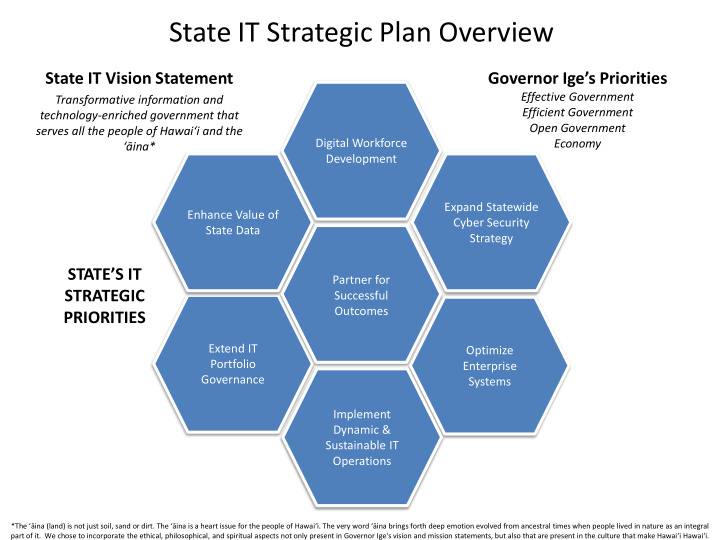



State IT Strategic Plan Overview State IT Vision Statement Governor Ige’s Priorities Effective Government Transformative information and Efficient Government technology-enriched government that Open Government serves all the people of Hawai‘i and the Digital Workforce Economy ‘ āina * Development Expand Statewide Enhance Value of Cyber Security State Data Strategy STATE’S IT Partner for STRATEGIC Successful Outcomes PRIORITIES Extend IT Optimize Portfolio Enterprise Governance Systems Implement Dynamic & Sustainable IT Operations *The ‘ āina (land) is not just soil, sand or dirt. The ‘ āina is a heart issue for the people of Hawai‘i. The very word ‘ āina brings forth deep emotion evolved from ancestral times when people lived in nature as an integral part of it. We chose to incorporate the ethical, philosophical, and spiritual aspects not only present in Governor Ige's vision and mission statements, but also that are present in the culture that make Hawai‘i Hawai‘i.
Extend IT Portfolio Governance • Strategy • Extend the State IT Governance Model to better align the state’s functions with resources and ensure the State follows industry best practices and garners the full benefits of its investments. • Team Lead: ETS Enterprise Architect
HRS 27-43(a) • ETS shall: – (1) Develop, implement, and manage statewide information technology governance ; – (3) Develop and implement statewide technology standards ; – (4) Work with each executive branch department and agency to develop and maintain its respective multi-year information technology strategic and tactical plans and road maps that are part of the State's overall information technology strategic plans, road maps, and directions;
HRS 27-43(a) • ETS shall: – (5) Coordinate each executive branch department and agency's information technology budget request, forecast, and procurement purchase to ensure compliance with the department or agency's strategic plan and road map and with the office of enterprise technology services' information technology governance processes and enterprise architecture policies and standards, including policies and standards for systems, services, hardware, software, and security management;
Departments/ Divisions NEW Budget Program Structure SharpCloud
Program Management
TIME Model T olerate Keep the application and consider investing further in it, if usage stays high (e.g. high utility in good technical condition). Tolerate the application as it serves its purpose (e.g. a certain degree of utility in good technical condition) or because there is no adequate alternative. I nvest Modernize the application because it has a high business value (e.g. application with high usage, but supported by outdated technology). M igrate Discard the application, migrate the data and users on an existing Application (e.g. redundant applications). Unify multiple applications to a common version/technology platform. Merge applications (either physical, logical or both). Replace the application with a standard commercial solution. E liminate Eliminate useless Applications (possible reasons: no business value, not used, low utility, based on obsolete software).
TIME/4 Rs Models Good Invest/Retain Tolerate/Redesign Eliminate/Retire Migrate/Refresh Poor Good
• ETS Enterprise Architecture System Demo • Business Capabilities Model
Systems • Human Resources • Payroll and Time • Financial Management • Human Services (KOLEA, BES, CWS) • Tax Modernization • Child Support Enforcement (KEIKI) • Benefits and Retirement • Public Safety & Criminal Justice • Labor Disability and Unemployment Insurance
QUESTIONS
BACKUPS
Recommend
More recommend